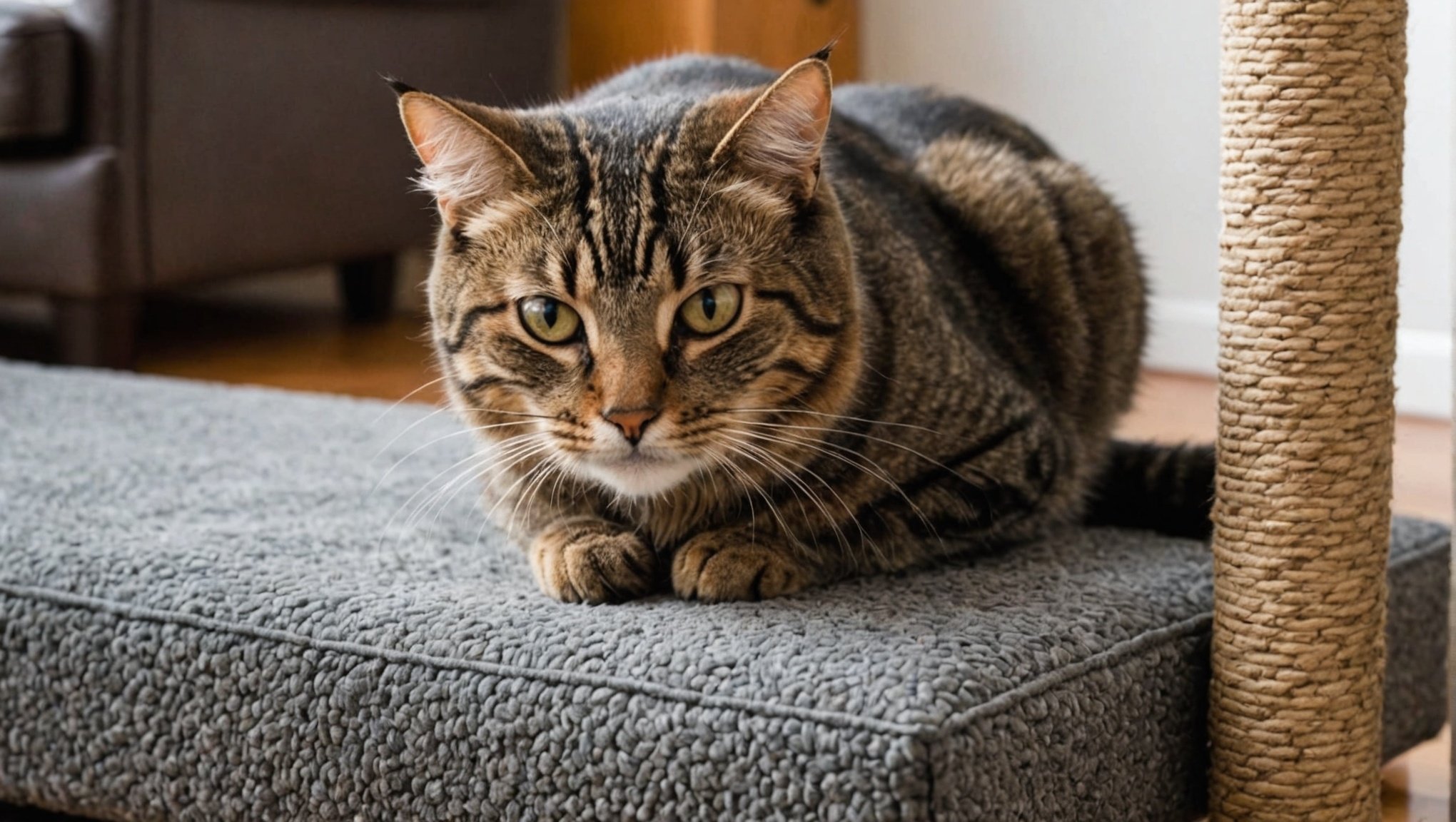Understanding Cat Scratching Behavior
Cats are fascinating creatures with a range of intriguing behaviors. Among these is their natural instinct to scratch. But why do cats scratch?
Cats scratch due to innate cat behavior that serves multiple purposes. Primarily, scratching helps cats to keep their claws in prime condition, removing worn outer sheaths and revealing sharp, new claws beneath. This makes scratching essential for their health and survival instincts, even in a domestic setting.
A lire également : Top Tips for Seamlessly Introducing New Toys to Your Cat
Scratching also plays a significant role in marking territory. Cats have scent glands in their paws, and when they scratch surfaces, they leave both a visible mark and a scent trail. This is an important form of communication in the realm of cat behavior.
Understanding your cat’s scratching habits can help you manage where and what your feline friend chooses to scratch. Often, furniture becomes a target due to its prominence in a home and the texture it provides, which cats find appealing.
A voir aussi : Identifying Feline Pain: Effective Signs and Proven Pain Management Strategies for Your Cat
To support your cat’s well-being while preserving your furnishings, consider providing a variety of scratching posts and boards. These can fulfill your cat’s need to scratch while sparing your furniture. Encourage their use by placing them in key locations and using catnip, ensuring they become an attractive alternative.
Choosing the Right Scratching Post
Scratch away, but do it smartly! Choosing the perfect scratching post involves a savvy understanding of scratching post types and fostering effective cat training. Let’s delve into some aspects to consider.
Materials and Textures
A cat’s scratching post must have materials that satisfy its instinctual needs. Common materials include sisal rope, corrugated cardboard, and carpet. Sisal rope is robust and provides a satisfying texture, favoured by cats. Cardboard, although less durable, is an affordable option appreciated by many felines. Carpet is comfortable but may be too similar to home furnishings, which might confuse cats during their training.
Sizes and Heights
Height and size are essential aspects when choosing a scratching post. Taller posts allow cats to stretch fully, mimicking natural behaviours and providing an exercise opportunity. Aim for a post approximating the height of your cat when fully extended. For larger breeds like Maine Coons, a proportionally taller post is crucial.
Stability and Design
Prevent mishaps by ensuring stability and structural integrity. A stable post reduces tipping risks, encouraging consistent use. Wide bases or wall-mounted designs enhance stability, ensuring the post remains upright even during vigorous scratching sessions. Prioritising design elements like ramps or perches can also enrich the cat’s environment, offering more engagement and enhancing overall effective cat training.
Training Techniques to Redirect Scratching
Redirecting your feline’s scratching habits plays a pivotal role in harmonious coexistence. A key is leveraging positive reinforcement techniques which encourage your cat to favour a scratching post. Offer treats, affection, and verbal praise once your cat uses an appropriate post, reinforcing this action as rewarding behaviour.
Equally important is discouraging furniture scratching effectively, without resorting to punishment. Implement deterrents such as sticky tapes or aluminium foil on favoured spots, which naturally deter due to their unpleasant textures. Ensure these strategies are consistently applied to communicate that furniture is not scratch-friendly, rather than causing confusion.
Consistency and routine are crucial in any training strategies. Dedicate a specific time for training sessions, adhering to a routine that cats, being creatures of habit, will find reassuring. Regular interaction and consistently rewarding desired behaviours solidify behavioural modification over time.
By employing these training strategies, you can significantly improve your cat’s scratching habits and protect your furniture. Remember, patience and understanding, along with consistency, form your best tools in making behavioural modifications. Always aim to make new habits more rewarding and pleasant for your furry companion. With gentle persistence, you will likely see fruitful results, ensuring a happier home for you and your pet.
Enhancing the Appeal of the Scratching Post
Capturing your cat’s interest in a scratching post involves strategic measures. Let’s explore how you can elevate its appeal.
Using Catnip
Catnip can be a game-changer when it comes to engaging your cat. Sprinkling a small amount directly onto the scratching post can work wonders. Cats are naturally drawn to the scent of catnip, and this can make them curious and eager to explore the post. For a stronger effect, consider rubbing dried catnip leaves into the fabric or carpet of the post.
Placement Strategies
Where you position the scratching post can significantly impact its use. Cats often prefer locations where they spend a lot of time or transition through frequently. Placing the post near their sleeping area or in living spaces can increase its usage. Avoid tucked-away corners; instead, place the post in visible and accessible spots.
Enticing Toys
Adding toys can elevate the attractiveness of a scratching post. Attach dangling toys or feathers to encourage interactive play. This not only distracts the cat but also entices them to scratch, climb, and engage with the post. Providing a variety of toys can sustain their interest over time. Including toys alongside catnip can double the allure of the post.
Mistakes to Avoid in Scratching Post Training
Training a cat to use a scratching post can be a rewarding experience, but common training mistakes can hinder progress. One of the main cat owner pitfalls is misunderstanding a cat’s preferences for scratching surfaces. Cats have distinct tastes in texture and form; some may prefer sisal, while others might favour cardboard or carpet. Observing your cat’s preferences can help in selecting the right post, enhancing training success.
Another frequent misstep is inconsistency in training responses and reinforcement. Cats thrive on routine, so erratic responses to their actions can lead to confusion. To avoid this, ensure consistent reactions to desired and undesired scratching behaviour. Positive reinforcement, such as treats or praise, when your cat uses the scratching post, can bolster this routine.
Ignoring signs of stress or discomfort is another pitfall. Cats might scratch inappropriately due to anxiety or discomfort in their environment. It is crucial to identify and address what might be causing these feelings. Look for signs such as hiding, excessive grooming, or aggression, which might indicate stress. Addressing these underlying causes can prevent undesired scratching and improve overall feline well-being. Thus, understanding these aspects can aid in a harmonious cohabitation with your furry friend.
Expert Insights and Anecdotes
Delving into the world of cat ownership, many seek guidance from professionals to navigate feline scratching behavior. Understanding such behavior enhances the bond between a cat and its owner.
Animal Behaviorist Recommendations
Animal behaviorists often suggest selecting a scratching post that mimics natural textures, like sisal. This encourages cats to use their post instead of household furniture. Position the post in areas where your cat spends most of its time, ensuring easy access. Consistency in placement is crucial as it creates a familiar environment for your feline.
Testimonials from Cat Owners
Many cat owners have shared heartwarming stories of triumph over furniture scratching habits. Cats that initially destroyed couches found solace in well-placed scratching posts. One owner, Emily, successfully redirected her cat’s attention by rewarding it with treats post-scratch, teaching positive association.
Tips from Veterinarians
From a veterinary standpoint, scratching is vital for a cat’s physical health. It aids in shedding worn claws and marking territory. Veterinarians advocate for multiple scratching posts in larger homes to accommodate a cat’s roaming instincts. Encouraging correct use not only preserves furniture but promotes mental well-being.











